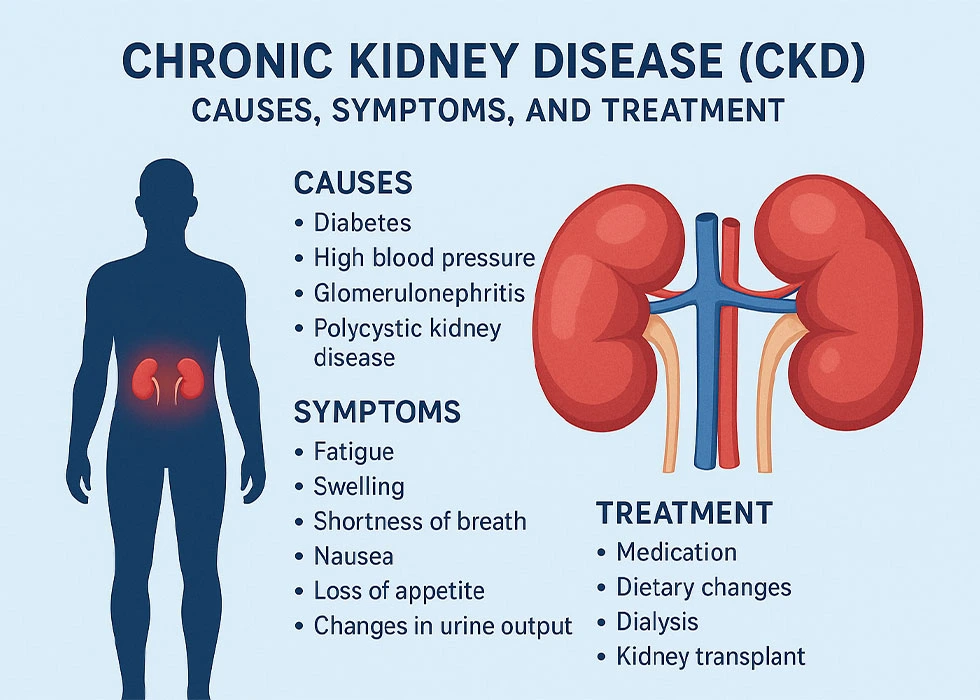
Chronic Kidney Disease (CKD): Causes, Symptoms, and Treatment
- August 12, 2025
- 1 Like
- 44 Views
- 0 Comments
Chronic Kidney Disease (CKD), also known as chronic kidney failure, is a long-term condition in which the kidneys gradually lose their ability to function. Our kidneys are vital organs that filter waste, toxins, and excess fluids from the blood, regulate important minerals, and help control blood pressure. When this function declines over months or years, harmful waste products begin to build up in the body, leading to a range of health problems.
What Causes Chronic Kidney Disease?
The most common causes of CKD are diabetes and high blood pressure. High blood sugar levels can damage the tiny blood vessels in the kidneys, while uncontrolled blood pressure increases strain on these same vessels. Over time, this damage reduces the kidneys’ ability to filter blood effectively.
Other possible causes include:
- Glomerulonephritis (inflammation of the kidney’s filtering units)
- Polycystic kidney disease (a genetic disorder causing cyst growth in kidneys)
- Autoimmune diseases such as lupus nephritis
- Recurrent kidney infections
- Urinary tract blockages from kidney stones, enlarged prostate, or certain cancers
- Long-term use of certain painkillers (NSAIDs)
Your risk increases with age, family history of kidney disease, obesity, heart disease, or previous kidney injury. Some ethnic groups, particularly African Americans, have a higher prevalence due to both genetic and socio-economic factors.
Symptoms of CKD
In the early stages, CKD is usually symptom-free. As kidney function worsens, signs may include:
- Swelling in the feet, ankles, or hands
- Fatigue and weakness
- Shortness of breath
- Changes in urination (more or less frequent, foamy or bubbly urine)
- Dry, itchy skin
- Nausea, vomiting, or loss of appetite
- Muscle cramps and trouble sleeping
These symptoms are not unique to CKD and may be caused by other health issues, which is why regular checkups are essential for early detection.
Stages of CKD
CKD is classified into five stages, based on the glomerular filtration rate (GFR), a measure of how well the kidneys are filtering waste from the blood.
- Stage 1: Normal kidney function but signs of damage (GFR 90+)
- Stage 2: Mild damage, still functioning well (GFR 60–89)
- Stage 3a & 3b: Moderate damage (GFR 30–59) — symptoms may start appearing
- Stage 4: Severe damage (GFR 15–29) — preparing for dialysis or transplant
- Stage 5: Kidney failure (GFR below 15) — dialysis or transplant required
Diagnosis
CKD is often detected through simple blood and urine tests:
- Blood test for GFR and creatinine levels
- Urine test for protein (albuminuria), which indicates kidney damage
Imaging scans or a kidney biopsy may be used to investigate structural problems or determine the cause of damage.
Treatment and Management
While CKD has no cure, treatment can slow its progression and manage symptoms. The primary goal is to control the underlying cause, such as keeping blood sugar and blood pressure within healthy ranges.
One of the leading causes and complications of CKD is hypertension (high blood pressure). When blood pressure remains uncontrolled, it puts constant stress on the tiny blood vessels in the kidneys, accelerating kidney damage and worsening CKD progression. At the same time, as kidney function declines, it becomes harder to regulate blood pressure — creating a dangerous cycle. Careful management of hypertension is therefore essential in protecting kidney health and slowing the advance of CKD.
Common treatment strategies include:
- Medications like ACE inhibitors or ARBs to lower blood pressure, SGLT-2 inhibitors (e.g., Jardiance®) for kidney protection, phosphate binders, and diuretics.
- Dietary adjustments, such as limiting salt, potassium, and phosphorus intake, and moderating protein consumption.
- Lifestyle changes — quitting smoking, exercising regularly, maintaining a healthy weight, and staying hydrated.
- Managing related conditions like high cholesterol, anemia, and bone health issues.
For late-stage CKD or kidney failure, dialysis or kidney transplantation becomes necessary. Dialysis can be performed through hemodialysis (blood filtration via a machine) or peritoneal dialysis (using the abdominal lining as a filter). A kidney transplant offers the best long-term outcome for eligible patients.
Prevention and Early Detection
The best way to protect your kidneys is to manage your overall health. This includes:
- Controlling blood pressure and blood sugar
- Eating a balanced, low-salt diet rich in fruits and vegetables
- Avoiding smoking and limiting alcohol
- Staying physically active and maintaining a healthy weight
- Avoiding excessive or long-term use of painkillers without medical advice
Regular checkups are especially important if you have risk factors such as diabetes, high blood pressure, or a family history of kidney disease. Early detection can make a huge difference, allowing for lifestyle and medical interventions that may delay progression for years.
Living with CKD
A CKD diagnosis can feel overwhelming, but many people live long and fulfilling lives with the condition. Working closely with your healthcare provider, following your treatment plan, and making healthy lifestyle choices are key to maintaining your quality of life. Support from family, friends, and patient communities can also make the journey easier.
Final Thought:
Chronic kidney disease may be a long-term condition, but it’s not a hopeless one. With awareness, early detection, and the right care, it’s possible to slow the disease, protect kidney function, and maintain a good quality of life.


Leave Your Comment